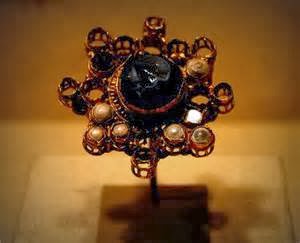I love to wear
jewelry, silver being my personal favorite. In my cultures, a family’s wealth
was held not in a bank but in the form of precious gems and metals. In the ‘higher’
ranking families, along with lands and titles, a bride could bring gold,
silver, and jewelry as part of her dowry. In turn, she would expect bling from
her husband for significant events through-out her marriage (children,
anniversaries, increase in rankings).
What type of jewelry was popular? Which gems were
available? Did the fashions resemble anything a woman (or man) might wear
today?
Wealth was kept in the form of jewelry, coins, cups,
goblets (also called hanaps), plates, boxes, and household decorations. Candelabras, chalices, crosiers (staffs),
vases, and royal jewels were usually special orders. The household goods
(plates, goblets, etc.) were decorated with family crests, heraldry, Celtic
designs, porcelain, glass, enamel, and/or encrusted with jewels.
 |
| ruby and diamond ring |
 |
Raw gemstones might be set aside for future use (to be
set in rings or sword hilts). Raw materials were formed to a finished product
by a metal smith, the final shape was dependent upon the individual (special
orders or on the whim of the maker). The more gold (or silver) & gemstones
used, obviously, the higher the cost and the more likely the item was a special
order. Common gemstones used included garnets, rubies, emeralds, sapphires, amethysts,
amber, pearls, and jasper. Colored glass and enamel were other features of
jewelry. Celtic designs, runes, royal insignias, heraldic crests, and names
were engraved in the metal work.
 |
| brooch with multiple gemstones |
 |
| medieval lover's brooch |
Rings, earrings, necklaces, brooches, torqs, arm rings (armillae),
pendants, buckles, garters, and buttons were popular pieces. Toadstone (or
talisman) rings were worn to promote healing. Diamonds did become popular in the 14th
century when the trade route through India opened up by sailors journeying around
the Cape of Good Hope. The craftsmen in Bruges were heralded as the best
cutters and the city soon was cited as the center of the diamond business, although
the jewelers eventually moved to Amsterdam.
 |
| Visigoth Crown |
Gemstones were polished and set in the pieces, the reason
diamonds weren’t very common (the stones were dark – the brilliance & fire
didn’t come through). Jewelers didn’t perfect the actual cut diamond as we know
it until the 15th century. The first cut was the ‘Rose’ cut and it
was developed by Giacomo Tagliacarne & Giovanni delle Corniole. The actual
techniques of jewelry-making were documented by Benvenuto Cellini's
'The treatises of Benvenuto Cellini on goldsmithing and
sculpture'.
 |
| gold and gemstone jewelry box |
Two buried
treasures discovered in recent times include the ‘Cheapside Treasure” and the ‘Staffordshire
Hoard’. The Cheapside Treasure’ is a collection of renaissance jewelry found
buried while workers were excavating for a hotel foundation in the Cheapside
area of London (England) in 1912. The Staffordshire Hoard is a collection of
Anglo-Saxon gold & silver artifacts found in a field by Hammerwich, a small
village near Lichfield (England) in 2009.
 |
| Renaissance pomander bottle |
Hoards of jewelry, weapons, household items, and miscellaneous
items have been found on occasion as old marshes, fields, or holes for foundations
or dug up. Some countries, such as Great Britain, have rules about historical
artifacts (treasures) being discovered and who has the ‘rights’ to owning them.
Others may subscribe to the ‘possession’ is 9/10th’s rule. Treasure hunters
should always know the laws of the land (local, regional, state, etc.) when
searching for any antiquities – especially if one intends on taking the find
out of the country.
 |
| Sutton-Hoo necklace |
For more information, see these
websites and references:
Stay safe out there!
Great post, Diane! I especially love the Visigoth Crown - very Game of Thrones, don'tcha think? ;)
ReplyDeleteDiana,
ReplyDeleteVery informative post & the pictures are gorgeous. Imagine what stories those treasures could tell!
Very nice posting which is very vital for me as well.All the rings are really very impressive and unique which is very conductive for me. Nice collection of silver and gold rings that's my idea. I must say if be possible keep one more website about this..
ReplyDeletecheap ring
Its a great pleasure reading your post.Its full of information I am looking for and I love to post a comment that "The content of your post is awesome" Great work. Camarillo Jewelry Store
ReplyDeleteWhat is so great about this blog is its uniqueness.
ReplyDeleteMavy Jewels
Excellent article. Very interesting to read. I really love to read such a nice article. Thanks! keep rocking. https://www.rockerring.com/
ReplyDelete